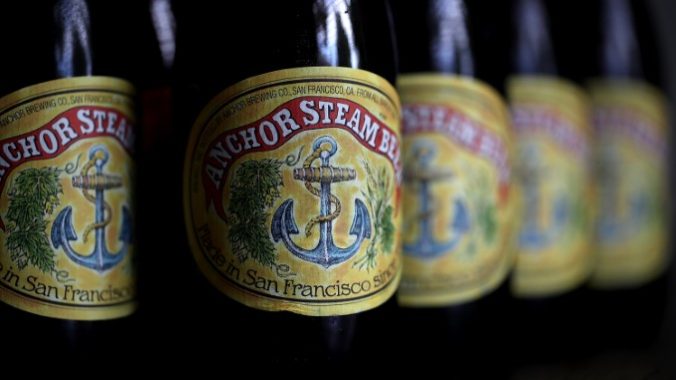The Closure Of Anchor Brewing Company: Impact On The Craft Beer Industry

Table of Contents
Financial Challenges and Market Pressures Facing Anchor Brewing
The demise of Anchor Brewing wasn't sudden; it was the culmination of several interconnected pressures impacting profitability and long-term viability.
Increased Competition in the Craft Beer Market
The craft beer market exploded in recent decades, leading to a fiercely competitive landscape. New breweries constantly enter the market, vying for limited shelf space in stores and bar taps. This intense craft beer competition significantly impacts smaller players like Anchor.
- Larger Breweries Gaining Market Share: Mega-breweries with extensive distribution networks and significant marketing budgets have aggressively expanded their presence in the craft beer segment, often acquiring smaller, independent breweries. This increased competition for both retail and consumer attention has made it harder for smaller brands to compete.
- Statistics on Craft Brewery Closures: The number of craft brewery closures has been on the rise in recent years, highlighting the difficulties of surviving in this challenging environment. While precise figures vary depending on the definition of "craft," industry reports consistently show a trend of consolidation and closures.
- Trending Beer Styles and Consumer Preferences: Consumer tastes evolve rapidly. The popularity of IPAs, sours, and other trendy styles can shift quickly, leaving breweries that fail to adapt struggling to stay relevant. Anchor Brewing’s classic styles, while beloved by many, may not have resonated as strongly with newer generations of beer drinkers.
Rising Costs of Production and Distribution
Beyond competition, Anchor Brewing, like many breweries, faced escalating production and distribution costs. These expenses significantly eroded profit margins.
- Raw Material Costs: The cost of key ingredients like hops, barley, and malt have fluctuated wildly in recent years, driven by factors like climate change and global supply chain disruptions. This impacted the overall cost of production and made it difficult to maintain consistent pricing.
- Distribution Challenges and Transportation Costs: Getting beer from the brewery to consumers is expensive. Rising fuel prices, trucking costs, and distribution network complexities further squeezed already-thin margins. The reliance on third-party distributors adds another layer of costs and complexities.
- Inflation and Supply Chain Issues: The broader economic climate played a role, with inflation impacting everything from energy costs to packaging materials. Supply chain disruptions also created uncertainty and increased expenses.
Strategic Decisions and Management Changes
Internal factors also contributed to Anchor Brewing's struggles. Ownership changes and strategic decisions played a crucial role in the brewery's decline.
- Ownership Changes and Management Decisions: Anchor Brewing changed hands multiple times over the years. Each change brought new strategies and priorities, some of which may not have been conducive to the long-term health of the brewery.
- Missed Opportunities and Strategic Errors: Some argue that Anchor Brewing missed opportunities to innovate and adapt to the changing market landscape. This could include failing to effectively capitalize on emerging trends in beer styles or to fully leverage the potential of direct-to-consumer sales.
- Marketing and Branding Strategies: The effectiveness of Anchor Brewing's marketing and branding efforts in recent years is a subject of debate. Whether the brand’s messaging successfully resonated with the evolving tastes and preferences of beer consumers is a crucial question.
The Wider Impact on the Craft Beer Industry
The Anchor Brewing closure carries broader implications for the craft beer landscape.
A Symbol of Change in the Craft Beer Landscape
Anchor Brewing's closure serves as a cautionary tale.
- Cautionary Tale for Smaller Breweries: The closure highlights the vulnerability of even long-established brands in a rapidly changing market. Smaller breweries, often with fewer resources, face even greater challenges.
- Consumer Perception and Confidence: The closure could potentially impact consumer confidence in the craft beer market, raising concerns about the long-term viability of smaller, independent breweries. This sentiment could negatively affect sales across the board.
- Reactions from Other Breweries and Industry Experts: The news prompted widespread discussion and analysis within the craft brewing community. Industry experts offered diverse opinions on the reasons behind the closure and its potential consequences.
Consolidation and Acquisitions in the Craft Beer Sector
The Anchor Brewing closure may accelerate a trend toward consolidation.
- Increased Consolidation and Acquisitions: Larger breweries might see this as an opportunity to acquire struggling craft breweries, furthering the trend toward consolidation within the industry.
- Implications for Independent Breweries and Craft Beer Diversity: This consolidation could threaten the diversity of the craft beer market, potentially leading to a reduction in the number of unique and independently-owned breweries.
- Impact on Availability of Unique and Smaller-Batch Beers: The decrease in independent breweries could lead to a homogenization of beer styles and a decline in the availability of more niche or experimental brews.
Opportunities for Innovation and Adaptation
Despite the challenges, the Anchor Brewing closure also presents opportunities.
- Adapting to Changing Consumer Preferences: Breweries must continuously adapt to the evolving tastes of consumers, offering innovative and exciting beer styles.
- Innovation in Brewing Techniques, Marketing, and Business Models: Embracing new technologies, marketing approaches, and business models are critical for success in a competitive environment. Direct-to-consumer sales and strong brand building are becoming increasingly important.
- Successful Examples of Adaptation: Many breweries have successfully navigated these challenges by focusing on innovative brewing techniques, creative marketing, and effective business strategies. Examining these success stories can help other breweries learn from best practices.
Conclusion
The closure of Anchor Brewing is more than just the loss of a beloved brand; it represents a significant turning point for the craft beer industry. The challenges faced by Anchor—increased competition, rising costs, and evolving consumer preferences—are issues that many craft breweries are grappling with. This event serves as a stark reminder of the need for adaptation, innovation, and strong business acumen to thrive in this dynamic market. Understanding the lessons learned from the Anchor Brewing closure is crucial for the survival and success of the craft beer industry. To stay informed on the evolving landscape and ensure the future of craft beer, continue to follow industry news and analyze trends in the craft beer market. The future of craft brewing relies on learning from the Anchor Brewing closure and adapting accordingly.

Featured Posts
-
 How Middle Management Drives Company Performance And Employee Engagement
Apr 29, 2025
How Middle Management Drives Company Performance And Employee Engagement
Apr 29, 2025 -
 Social Media And The D C Midair Collision A Case Study In Misinformation
Apr 29, 2025
Social Media And The D C Midair Collision A Case Study In Misinformation
Apr 29, 2025 -
 Black Hawk Helicopter Collision Pilot Error Leading To American Airlines Near Miss
Apr 29, 2025
Black Hawk Helicopter Collision Pilot Error Leading To American Airlines Near Miss
Apr 29, 2025 -
 Remuera Incident Leads To Detention Of Du Val Founder
Apr 29, 2025
Remuera Incident Leads To Detention Of Du Val Founder
Apr 29, 2025 -
 Israeli Airstrike In Beirut Evacuation Warning Issued
Apr 29, 2025
Israeli Airstrike In Beirut Evacuation Warning Issued
Apr 29, 2025
